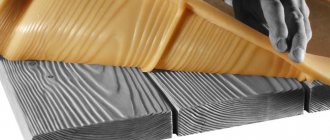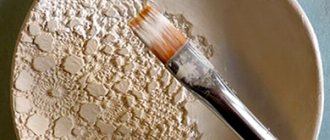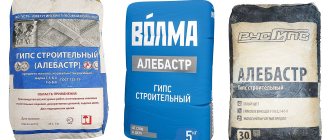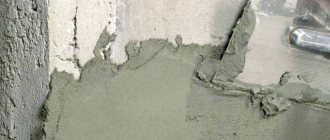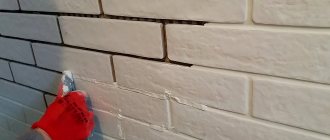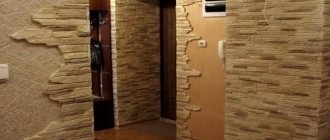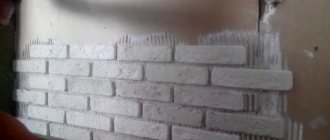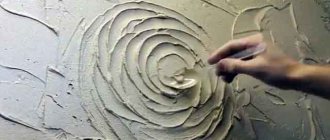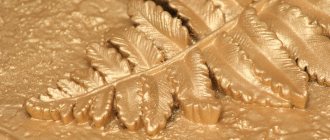What is a retarder for gypsum plaster
QUALITATIVELY
FAST
SEO optimization
Adaptive layout
Repair in the regions
- home
- Construction
- Wet plaster
- Set retarders for plaster mortar
Set retarders for Portland cement are iron sulfate and a weak solution of sulfuric acid. They are used if the rate of thickening of the mortar mixture without additives does not provide the workability necessary for the work.
To slow down the setting of gypsum binders, special retarders are used. Gypsum set retarders are widely used for the preparation of gypsum mastics, which are used for gluing sheets of gypsum dry plaster when covering surfaces with them, during the mechanized application of lime-gypsum plaster, as well as in the preparation of lime-gypsum or gypsum mortar for sandless covering of plaster.
Liquid adhesive lime gypsum retarder is available for production in construction environments and is most widely used. This retarder consists of animal glue (tile, gallerate or liquid), lime (fluff or lime paste) and water.
To prepare a gypsum retarder, one weight part of animal glue based on dry glue (tile adhesive is soaked in water for 8-12 hours until complete swelling) and one weight part of lime are placed in a boiler and filled with five weight parts of water. The whole mass is heated to boiling point, and then simmered over low heat for 4-6 hours.
The mass is stirred periodically to protect the organic matter (glue) from burning. The boiler should be filled to no more than 2/3 of its volume. The boiler loading limit is marked with a mark. As the moisture evaporates during the boiling process, water is added to the boiler until the risk is reached. At the end of cooking the retarder, the mass is diluted with cold water so that for every kilogram of welded glue (in terms of dry matter) there are 9 liters of water. This retarder has a 10% concentration.
The required dose of retarder for mixing lime-gypsum mortar or gypsum (gypsum sawdust, foam gypsum) mastic is determined by experimental selection after testing the effect of the retarder for the setting period of the composition. So, for example, to obtain 10 liters of lime-gypsum mortar of working consistency, 0.1 liters of retarder are added to the mixing water. A small sample is taken from the prepared solution and every 5 minutes. After mixing the solution, a wire with a diameter of 1.5-2 mm is lowered into it and immediately removed.
The test using a wire is continued until the trace in the solution stops floating after the next lowering of the wire. The time from the moment the solution is mixed until the solution stops floating at the test site with the wire is the period for loss of fluidity of the solution. If the period of loss of fluidity is more than 50 minutes, then the dose of the retarder in the solution should be reduced; if this period is less than 35 minutes, then it should be increased. A retarder is added to gypsum mastics for gluing dry plaster according to the recipe for the appropriate composition.
Gypsum production
Today, gypsum is widely known as a building material used for finishing and plastering work. It is also used in architecture and landscape design.
Extraction, what gypsum is made from
Gypsum is mined in deposits by blasting gypsum-containing rock. The ore is then transported to factories in the form of gypsum stones. They are crushed in special crushers and then dried to evaporate the moisture present in them.
Dry fractions are crushed in mills to a powder state and sent to a kiln for firing. The powder is fired for 1-2 hours at a temperature of 150-160 degrees. The output is a finely dispersed white mixture, completely ready for use.
Place of Birth
Gypsum is widespread throughout Russia. The main places of gypsum production are the Vladimir, Arkhangelsk and Irkutsk regions, Central Asia, the Volga region, Bashkiria and the Western Urals. Other countries include Spain, Tunisia, Greece and Morocco.
Gypsum deposits arise due to the following factors:
- Weathering of salt deposits.
- In places where there are salt lakes, it forms as a chemical precipitate.
- It is an accompanying rock in old oil, sulfur and anhydrite deposits.
- Often mineral deposits are discovered at the mouths of ancient rivers.
The video shows how gypsum is mined and processed at the Forman plant:
Compound
The chemical composition is an aqueous solution of calcium sulfate. Its chemical formula is Ca[SO4]? 2H2O. When heated to 140 degrees, water is released from its crystal lattice, resulting in the formation of so-called semi-aqueous gypsum.
If you continue heating the mineral, building (burnt) gypsum is formed. This material is used in powder form. If water is added again to such a powder, the water will join the calcium sulfate, and the material will become hard.
Sump
To separate gypsum and sand from the water mixture, special devices called gypsum separators are used. They allow you to collect gypsum and sand in a separate container, and direct the water to the drainage system. The sump must be connected between the sink and the drain pipe.
Gypsum retarders
Slaked lime slows down the end of setting by 15 - 20 minutes; is introduced in an amount of 5 - 20% of the weight of gypsum.
Alum and borax slow down the end of setting by 15 - 20 minutes; is introduced in an amount of 5 - 20% of the weight of gypsum.
The drug BS is administered in an amount of 2 to 7 kg per 1 m 3 of lime-gypsum solutions. Extends setting time by 30 - 50 minutes.
Animal hide and bone glue is used in the form of a solution of 10% aqueous concentration at the rate of 0.2-0.5% (on a dry basis) of the weight of gypsum.
The adhesive-lime retarder is prepared by treating the adhesive with lime: 1 wt. part of the glue is soaked 5 wt. parts of water, after 15 - 16 hours add 1 weight part of lime paste and boil for 5 - 6 hours, adding evaporating water. To 7 parts by weight of the finished decoction add 3 parts by weight of water, obtaining a 10% adhesive solution, which is used as a retarder at the rate of 0.2 - 0.5% (on a dry basis) of the weight of gypsum. As a retarder it is more effective than animal glue. Extends setting time by 20-30 minutes.
A keratin retarder is prepared from animal horns and hooves, treating them with a 15% caustic soda solution: 70-80% of the horns and hooves are poured with a 20-30% caustic soda solution. Keep in a wooden container for two to three days. Softened horns and hooves are boiled in the same caustic soda solution at a temperature of 85 - 90 C until completely dissolved. The cooled composition is filtered through a sieve (mesh size 0.3 mm) and poured into a glass container. Apply in an amount of 0.1 - 0.3% (on a dry basis) by weight of gypsum. Extends setting time by 30 - 50 minutes.
Method for retarding the setting of plaster and preparations with gypsum
The invention relates to a method for retarding the setting of gypsum and preparations with gypsum, as well as a composition for implementing this method. A method for retarding the setting of gypsum and preparations with gypsum involves adding a chemical substance of the following composition: a) tartaric acid in an amount of at least 0.01 to 1.0 wt.%, based on the amount of gypsum; b) sodium trimetaphosphate in an amount of from 0.05 to 0.5% by weight, based on the amount of gypsum; c) if necessary, sodium polyphosphate with an average chain length of at least 4 to 50 phosphate units. Gypsum and preparations with gypsum contain the above components. The technical result is improved regulation of the setting process at its final stage, increased processing time. The invention is developed in dependent claims. 2 n. and 2 salary f-ly, 4 ill.
The proposed invention relates to a method for retarding the setting of gypsum and preparations with gypsum, as well as a composition for implementing this method.
Scope of the invention
In the construction industry, large quantities of gypsum and gypsum preparations are processed.
Construction plaster includes finishing gypsum and alabaster, which can be used with various additives to achieve certain properties.
Finishing gypsum is a β-hemihydrate and is mainly used to produce gypsum boards, gypsum building panels, interior plasters such as finishing plaster, etc.
Alabaster consists of the products of dehydration of calcium sulfate dihydrate at high and low temperatures, in particular anhydrite II and β-hemihydrate.
This gypsum is also used to produce interior plasters. It is a little more profitable, since it sets somewhat slower and can be processed for a longer time than finishing gypsum.
The relatively short setting times of finishing plaster and alabaster have long prompted the search for additives that can be used to process larger quantities of mixtures on site without being constrained by short cycle times.
State of the art
Suitable substances for retarding the setting are described in the prior art and in the literature, for example by such authors as Kruis und Spain, Benz, Harvey und Neville (cf. Kunze, RA, Thayer, AG, Gypsum and Plaster Cem. Res. Prog (1986) pp.267-283).
The plaster processing time lasts between the start of hardness (VB) and the end of hardness (VE). The setting characteristic can be determined using the released heat of hydration (although indirectly and imprecisely; see Hans-Bertram Fischer, Martin Werner: Hydratationsverhalten von Gipsmischungen, Stuck, Putz, Trockenbau, 9/94, pp. 16-22), as well as by the method Vika, DIN (German Institute of Industrial Standard) 1168 part 2 or using ultrasonic measurements Con. Chem. — Journal, 4 Jahrgang 3/96.
Known retarders can be divided essentially into three groups:
a) polymers/copolymers based on acrylate, described, for example, in patent EP 1270530;
b) various phosphate salts described, for example, in US patent 5,746,822;
c) carboxylic acids and their derivatives, described, for example, in DE PS 2226943.
DE PS 2226943 describes the effect of organic substances, especially organic fruit acids, tartaric acid and malic acid on the setting behavior of gypsum. Within the scope of this invention, it has been discovered that the addition of 0.1 wt.% retarder, based on the amount of gypsum, slows down the setting time by at least 10 minutes. Another additive, polymerized glyoxal, is also described here, which is added to the mixture in approximately equal quantities. The mixtures described here slow down only the beginning of setting of the gypsum. However, it is also necessary to manage the entire process, i.e. both the beginning of setting and its end.
The book Zement, Kalk, Gips, 1988, p. 309 ff describes the action of various compounds as retardants depending on the pH value.
It has been found that the retardation of the setting of tartaric acid and tartaric acid salts occurs very well in a highly alkaline environment. Here, a test was carried out with tartaric acid in an amount of 0.2 wt.%, based on the amount of gypsum. Mixtures with phosphates were not described or tested here.
From DE 10017133 another method is known for retarding the setting of gypsum and preparations from gypsum, which is characterized in that 0.001-1 wt.%, based on the weight of gypsum, of at least one polymer with repeating units of succinyl is added. The polymer may be polyaspartic acid or polysuccinimide or one of their salts and has a molecular weight of from 500 to 10,000, preferably from 1000 to 5000. The action of these polymers is very good, the difference between the beginning of setting and the end of setting is 25 minutes with pure beta hemihydrate in quantity 0.03 wt.%.
Another retarder was published in Zement, Kalk, Gips International, No. 9, 1999. The action of imidodisuccinate as a retarder for machine-made alabaster at 0.06 wt.%, based on the amount of gypsum, is described here as very beneficial. Mixtures with phosphates are also not mentioned here.
In this regard, mention should also be made of US 20030100648. This application describes the use of an agent that is used to improve the surface properties of set gypsum containing material. The agent used here consists of a mixture containing at least monobasic phosphate, trimetaphosphate and acrylic polyphosphate. The object of this invention was to improve the surface hardness, wear resistance and water resistance of the gypsum surface. Such an improvement can apparently be achieved only when the so-called inhibiting re-calcination can be avoided, which technically means the return of the set gypsum to the form of hemihydrate. This process is not identical to hemihydrate retardation. The cyclic phosphate used here is sodium trimetaphosphate. Sodium trimetaphosphate is used in this invention solely to solve the above problem, setting retardation using sodium trimetaphosphate is not the subject of this publication.
US Pat. No. 5,746,822 describes a joint compound for cement which also contains calcium sulfate hemihydrate as a filler. In order to be able to regulate the processing time, this mass contains other additives, including phosphates, which slow down the setting of the mass in the presence of water. Claim 2 describes phosphate salts suitable for retarding, for example zinc phosphate, sodium tetrapyrophosphate, sodium polyphosphate, monoammonium phosphate and monobasic potassium phosphate. Cyclic sodium trimetaphosphate is not mentioned here and is not the subject of the invention.
US Pat. No. 6,342,284 describes the production of gypsum boards. The objective of the invention was to improve the mechanical stability of plasterboard boards under long-term loads. In this invention, tests were carried out with various phosphate salts. Gypsum mixtures were prepared that contained both calcium sulfate hemihydrate, calcium sulfate dihydrate, and anhydrite in combination with various phosphate salts. According to Example 1, gypsum mixtures were prepared, among other things also with sodium trimetaphosphate (STMP). Table 2 shows studies of the compressive strength of the products. It was found that STMP additives had a particularly good effect on the compressive strength of the boards. Table 2 shows the results of tests with mixtures of mechanical stability of slabs made with such gypsum mixtures. Here too, the mixture containing STMP was particularly good. Gypsum boards were additionally treated with STMP solutions in a number of the following tests. The solutions were sprayed onto the surface of calcium sulfate dihydrate and dried again. In Fig. 5 one can see the remarkable effect of STMP in relation to “sag deflection”, i.e. the bending strength of the slabs. Although STMP performed very well in a number of mechanical tests with slabs, it was found (column 4, line 42 ff) that STMP does not have a set retardant effect, i.e. the proportion of conversion of calcined gypsum to calcium sulfate dihydrate does not increase. Thus, this action from US patent 6,342,284 cannot be borrowed, on the contrary, such an action was even clearly denied.
The object of the present invention is to find another effective retarder for gypsum and preparations with gypsum, such as machine-made alabaster, hand-made gypsum plaster, REA gypsum, as well as natural gypsum.
Moreover, the object of the invention is to supplement or replace known standard retardants, such as tartaric acid or polyphosphates, with other effective products. An essential part of the formulation of the problem was, first of all, the possibility of better regulation of the setting process, in particular at the final stage of setting. The processor must have more time to process.
Based on the technical solutions described above, it was unexpected that the inventor of the proposed invention found that it is possible to combine a standard retarder - tartaric acid - with a mixture of phosphate salts, and, on the one hand, the amount of tartaric acid can be significantly reduced, and on the other hand, it was possible to regulate the setting process, in particular at its final stage, and specifically level the characteristic of the curve during setting. This leaves the processor more time to process at the final stage of the setting process.
The method proposed in accordance with the invention is characterized in that to slow down the setting of gypsum and preparations with gypsum, a composition is used that includes the following components:
a) tartaric acid in an amount of at least 0.01 to 1.0% by weight, based on the amount of gypsum;
b) sodium trimetaphosphate in an amount of from 0.05 to 0.5% by weight, based on the amount of gypsum;
c) if necessary, sodium polyphosphate with an average degree of condensation from n=4 to n=50, and component (b) is used, and, if necessary, (c) as a mixture of phosphate salt, and the proportion of sodium trimetaphosphate in the mixture of phosphate salt is at least 50 parts by weight.
Components (b) and, if necessary, (c) are mixed together in a dry state and added to retard the setting of the gypsum in the form of a fine-grained powder with a grain size distribution of at least 95% of the component less than 200 microns. The gypsum is then mixed with water in the usual manner and further processed.
The selection of sodium trimetaphosphate from among known phosphates is novel and inventive. When solving the problem of finding another phosphate-containing retarder, the applicant could not find any information from known inventions.
Component c) sodium polyphosphate is a condensed phosphate with a chain length of at least 4 to 50, i.e. from 4 to 50 units of phosphate are interconnected by a normal chain.
The compound used according to the invention is sodium trimetaphosphate with the general formula Na3(P3O9), a cyclic phosphate with CAS No. 7785-84-4 and is also commercially available from BK Giulini GmbH under the type name Targon. By adding sodium trimetaphosphate, the gypsum processing time is significantly increased. This effect was tested in technical application trials. The results are described below.
Technical application experiences and results:
Example 1, Fig.1
In this experiment, tests were carried out on 3 mixtures in standard plaster:
1) 0.065 wt.% tartaric acid and 0.13 wt.% sodium tetrapyrophosphate (for comparison);
2) 0.065 wt.% tartaric acid and 0.13 wt.% sodium polyphosphate (for comparison);
3) 0.065 wt.% tartaric acid and 0.13 wt.% sodium trimetaphosphate (according to the invention).
Mixture 1 is not suitable, the processing time is too short, the curve is too steep. When using mixture 2, the processing time is slightly longer, which can be determined by a more even curve. Mixture 3 is especially suitable: the nature of the curve is smooth, and the time for slowing down the setting at the final stage is most suitable. With mixture 3 containing sodium trimetaphosphate, the best results are achieved.
Example 2, Fig.2
In this experiment, hand-made gypsum plaster was mixed with three different retarding compounds.
1) 0.065 wt.% tartaric acid and 0.13 wt.% sodium polyphosphate;
2) 0.065 wt.% tartaric acid and 0.13 wt.% sodium trimetaphosphate;
3) 0.065 wt.% tartaric acid and 0.075 wt.% sodium trimetaphosphate.
This experience shows that mixture 2 works very well, but when the amount of sodium trimetaphosphate is reduced by 40% the result is even better than the result with mixture 1.
Example 3, Fig.3
Machine made plaster was mixed with the two mixtures and the setting time was examined.
1) 0.1 wt.% tartaric acid and 0.14 wt.% sodium polyphosphate;
2) 0.1 wt.% tartaric acid and 0.14 wt.% sodium trimetaphosphate.
The retarding action of sodium trimetaphosphate is clearly superior to that of sodium polyphosphate in the same amount.
Example 4, Fig.4
Another test with machine made plaster was carried out with the following mixtures:
1) 0.14 wt.% tartaric acid and 0.11 wt.% sodium polyphosphate;
2) 0.14 wt.% tartaric acid and 0.11 wt.% phosphate salt according to the invention in combination with 0.033 wt.% sodium polyphosphate and 0.077 wt.% sodium trimetaphosphate;
3) 0.1 wt.% tartaric acid and 0.07 wt.% phosphate salt according to the invention in combination with 0.021 wt.% sodium polyphosphate and 0.049 wt.% sodium trimetaphosphate.
In combination with tartaric acid as a retarder in an amount of only 0.1% by weight, the amount of sodium trimetaphosphate can be reduced by even 40% compared to the amount of sodium polyphosphate, and the setting process, especially with regard to the end of setting time, is optimal.
All phosphate salts used in this invention can be found commercially.
Sodium tetrapyrophosphate has the formula Na4P2O7 sodium polyphosphate has the formula NanPnO3n+1, where n is from 4 to 50, and sodium trimetaphosphate has the formula (NaPO3)3. These phosphates are among others included in the invention. They are, without exception, fine-grained powder.
In relation to sodium polyphosphate, we are talking about condensed phosphate, which is obtained as a result of thermal condensation when water is removed from acid monophosphates. The salts used in the context of this invention have a degree of condensation n from 4 to 50. The degree of condensation indicates how many P atoms are present in a molecule in the product.
Sodium trimetaphosphate is a cyclic phosphate, which is obtained by cooling the corresponding polyphosphate melt and then maintaining it at temperatures above 350°C. The method for producing phosphates is not the subject of this invention.
Tartaric acid has the formula C4H6O6 and the chemical designation 2,3-dihydroxybutanedianic acid or also 2,3-dihydroxysuccinic acid. It appears in 3 stereoisomeric forms. It is a strong acid, highly soluble in water. Within the scope of this invention, the L-form is used; the use of other stereoisomers is not possible for technical reasons and these compounds are not suitable.
Measuring the setting characteristics is carried out using the ultrasonic method.
This method is based on the fact that the speed of sound in the mixture under study constantly increases throughout the hydration process. The measurement is non-destructive and can also be used over time as often as desired. The ultrasonic measuring instrument is suitable for measuring setting processes for the following reasons:
1. After mixing the test material, such as plaster, gypsum, mortar or concrete, the speed of sound increases due to constantly increasing hardening and approaches the limit value at the end of the setting process.
2. The instrument operates at a sound frequency of approximately 45 kHz, which is particularly suitable for measuring relatively heterogeneous material.
3. The device can store approximately 500 measurement values. These values can be transferred after measurement to a personal computer, and from the computer can be output in the form of tables or graphs of curves.
Here you can refer to the literature, primarily to the works of the authors T.Staffel, G.Brix “Untersuchungen des Abbindeverhaltens von Zementmischungen mit der Ultraschallmethode bei Einsatz verschiedener Verzögereradditive” in ConChem-Journal, 4-Jahrgang, 3/1996 and the author J.Balau, ConChem-Journal, 2/1996.
1. A method for retarding the setting of gypsum and preparations with gypsum by adding a chemical substance, characterized in that the following composition is used as a chemical substance: a. tartaric acid in an amount of at least 0.01 to 1.0% by weight, based on the amount of gypsum; b. sodium trimetaphosphate in an amount of 0.05 to 0.5 wt.% based on the amount of gypsum; With. if necessary, sodium polyphosphate with an average chain length of at least 4 to 50 phosphate units.
2. The method according to claim 1, characterized in that components b and/or c are mixed in dry form and in the form of a fine-grained powder with a grain size distribution of at least 95% of the components less than 200 μm, added to the gypsum for slowing down setting.
3. The method according to claim 1 or 2, characterized in that a composition is used in which the proportion of sodium polyphosphate is at least 0.01 wt.% based on the amount of gypsum.
4. Gypsum and preparations with gypsum contain the components listed in paragraphs 1-3.
What additives to the mixture increase the hardening time of gypsum plaster
Gypsum as a building material is used in a large number of different construction works, where it plays the role of a special additive that accelerates the hardening process of various types of solutions.
In some cases, alabaster is used in its pure form, for example, when it is necessary to quickly secure a wire in a groove, fix a socket, or other similar work.
The main advantage of the material itself is the speed of its setting, but in some cases this process needs to be slowed down. In this case, various types of retarders of organic or inorganic origin are used, which can be purchased at a hardware store or found in the home kitchen.
The need to slow down the setting
First of all, increasing the setting time of the gypsum mixture will be relevant when there is no desire to dilute small portions of the mixture several times.
When using retarders, it becomes possible to dilute from 1 to 2 kilograms of dry matter at once, which makes it possible to perform a significantly larger volume of work.
General rules for performing work
Before using appropriate moderators, a few simple rules must be observed, otherwise the addition of any substances will become useless:
- Mixing the mixture should only be done in clean containers made of plastic.
- Only clean tools should be used for mixing.
- First, water is poured into the container for preparing the mixture, and only then dry gypsum powder is poured.
The fact is that if there are mortar residues from previous batches on the tool or container, the setting of the plaster will be 2-3 times faster. Also, the gypsum mixture will set faster when pouring water into the dry substance.
Application of retarders
Such substances are special additives that increase the hardening time. They are divided into organic and inorganic.
A complete list of moderators whose effectiveness has been proven by practical tests:
- PVA glue;
- special glue for wallpapering;
- dishwashing detergent, such as Fairy;
- various types of liquid soap;
- boric and citric acid;
- washing powder;
- Vetonit brand putty;
- milk with liquid 3.2%;
- plasticizer for concrete mortar.
Sometimes it makes sense to add sand to the gypsum mixture, which increases the hardening time of the mixture and increases strength.
It is necessary to add milk in an amount of 10% of the total volume of water; with a larger amount, the setting time will increase.
Acid is added in the proportion of one sachet per 5-10 kilograms of dry mixture.
Preparation of the solution
To prepare the gypsum mixture, add a certain amount of gypsum to the water, stirring continuously. The foam that appears during the preparation of the composition must be removed, as it can make the future product brittle. The thickness of the solution depends on the ratio of the amount of water and gypsum.
Given the high speed of setting of the solution, sometimes it becomes necessary to slow down this process. After all, it is not always convenient to prepare the solution in small portions. And simply adding water to an already prepared mixture can ruin all the work done previously. That is why craftsmen use various compositions to slow down the hardening of gypsum putty.
Important. Gypsum has the ability to expand slightly when hardening.
Additives for gypsum
Since gypsum consists of a rather fragile substance - calcium, to improve the quality of the resulting material, various substances and impurities are added to it.
Impregnations
Gypsum surfaces are porous and therefore require impregnation with special compounds. The pores are filled, and after drying the surface is considered ready for further painting. Natural drying oil is usually used as impregnation.
Plasticizer
With the help of additives such as plasticizers, it is possible to change the setting time of the gypsum solution, as well as control the degree of its fluidity. In addition, some types of plasticizers are capable of imparting additional strength to finished gypsum products. In general, there has been an increase in the production rate of gypsum products and more efficient and rational use of equipment.
Water repellent
Hydrophobizing compounds intended for introduction into gypsum solutions serve to reduce the water absorption of gypsum while maintaining its vapor permeability. This avoids the appearance of condensation on the surface of the plaster even when a sharp temperature difference occurs.
In addition, such additives increase the strength of the hardened product or gypsum surface and protect it from the formation of mold and mildew. The water repellent penetrates into the pores of the gypsum and begins to act immediately after drying.
The principle of operation of the water repellent
Varnishes are used for finishing ready-made gypsum surfaces. The fact is that it is necessary to reduce the absorbency of gypsum, that is, to close its pores. To do this, it is recommended to saturate the surface with drying oil or varnish. It is better to use water-soluble varnishes based on acrylic or resin.
This composition penetrates deep into the pores of gypsum, and on its surface forms a thin and durable film with good adhesion. Such a surface will be reliably protected from moisture. For example, we can name several types of plaster varnish: “Izoplen”, “Dulux Trade Acrylic”, “Izo Sol”.
Some types of glue are used as additives in gypsum solutions. This not only increases the strength of the finished products, but also increases their water resistance. Most types of glue promote a slower setting of the solution. PVA glue, bone glue, wallpaper glue (WMC) and other types of adhesives are usually used.
Paint (pigment)
In order to give gypsum products unusual colors, powdered iron oxide pigments are used. They are available in powder form in various colors. Pigments do not dissolve in water, organic solvents and other liquid media, so colored plaster will not lose its color over time.
Retarder
Gypsum tends to harden very quickly, so it is recommended to use retarders that can increase the durability of the gypsum mortar. The amount of such an additive depends on its type. Sodium tartrates, which are salts of tartaric acid, as well as sodium citrates (salts of citric acid) are used as additives.
How to dissolve plaster
The dry gypsum mixture is dissolved with ordinary water. The higher the temperature of the water, the faster the reaction of the transition of the liquid solution into the solid state occurs. After hardening, gypsum does not dissolve in water.
However, if you store a hardened gypsum product or just a piece of hardened gypsum in conditions of high humidity, then the strength of the gypsum gradually decreases and the gypsum becomes brittle. To be reused, hardened gypsum is calcined in an oven to remove excess moisture and then ground into powder.
How to increase strength and make it stronger
To increase the strength of gypsum surfaces or products, it is recommended to introduce special additives into the solution. These are polymer fiber, various types of glue (CMC, PVA, bone glue), fluff lime, borax, liquid glass. Excellent results are obtained by reinforcing gypsum surfaces with a polymer mounting mesh.
To give a gypsum product strength comparable to the strength of ceramics, it is immersed for a day in a saturated solution of potassium alum. Then the product must be heated to a temperature of 550 degrees. You will be surprised by its durability.



